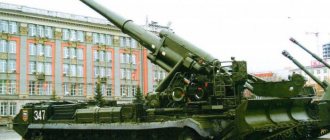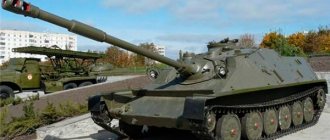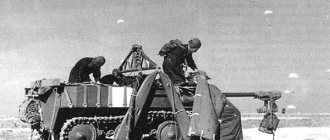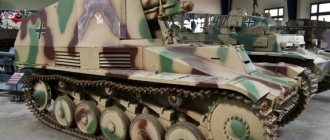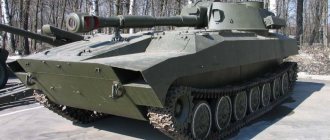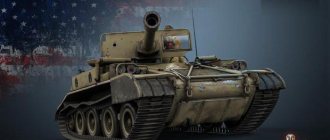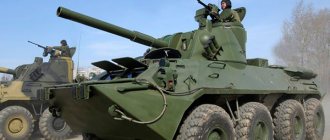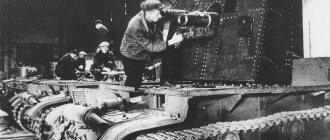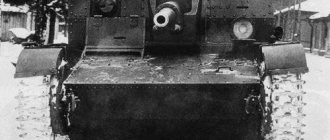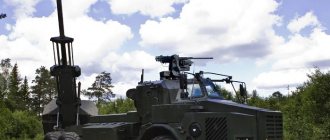Many people interested in army armament issues have formed the largely erroneous opinion that barrel artillery has become practically unclaimed under existing conditions. And in fact: it would seem, why is it needed when missile weapons reign on the battlefield? Take your time, it's not that simple.
The fact is that barrel artillery is much cheaper to produce and operate. In addition, provided that optical-laser-guided projectiles (Kitolov-2) are used, it is capable (at a normal distance, of course) of showing results no less impressive than missiles on the battlefield. We should also not forget about the possibility of using small-sized atomic charges. In a serious war this can be extremely useful.
That’s why today we will discuss the Giatsint self-propelled guns, one of the most impressive systems of this class.
Background
During the Second World War, self-propelled artillery guns established themselves as powerful and dangerous weapons, the presence of which could often decide the outcome of the battle in favor of one side or another in the conflict. Their price was significantly lower than that of tanks, but in certain conditions, cheap and not very well armored vehicles could effectively destroy heavy enemy armored vehicles. For our country, this was especially important at the initial stage of the war, when there was a catastrophic shortage of military equipment, and its production needed to be simplified and made as cheap as possible.
Almost all motorized rifle divisions of the USSR in the post-war period were equipped with tanks and self-propelled guns on a mixed basis. Each motorized rifle regiment had high-quality artillery weapons, which were represented by a full SU-76 battery. The share of other artillery weapons, which were created during the war, has increased significantly.
All self-propelled guns put into service during that period were intended exclusively to support attacking infantry in battle. However, in the post-war period, military doctrine increasingly prescribed the use of self-propelled guns together with or instead of tanks.
In the 50-60s, the role of self-propelled guns was constantly declining. Often the question arose about completely stopping their production and replacing this type of weapon with tanks. Thus, by the mid-60s, very few new models of self-propelled guns had been developed. Almost all of them were based on old tank chassis from the Second World War, equipped with new armored hulls.
Service and combat use
Organizational structure
The 2S5 self-propelled gun entered service with artillery regiments and brigades of the armies of the USSR Ground Forces to replace the M-46 and M-47 guns. Each artillery brigade consisted of 5 divisions (4 cannon-self-propelled artillery and 1 reconnaissance), each artillery division consisted of three batteries. The artillery batteries consisted of six 2S5 self-propelled guns (a total of 18 guns in the division), but some divisions had 4 batteries of 6 152 mm guns or 3 eight-gun batteries (that is, 24 guns in the division).
Service
Self-propelled guns 2S5 were in service with the following formations:
Combat use
The 2S5 self-propelled gun received its baptism of fire during the war in Afghanistan. 152-mm high-explosive fragmentation shells made it possible to guarantee the destruction of any enemy fortification. They were used to a limited extent as part of battalion tactical groups in the First Chechen Campaign. In 2014, during the armed conflict, 2S5 self-propelled guns of the Ukrainian armed forces were transferred to eastern Ukraine, where by the beginning of September 2014, 2 2S5 self-propelled guns were captured by the forces of the LPR and DPR.
Decline of the industry
At the end of the 50s of the last century, Nikita Khrushchev, a passionate fan of missile weapons, sanctioned an almost complete stop in the development of barreled weapons in the USSR. Because of this, we are decades behind our potential opponents. History has repeatedly punished the USSR for this miscalculation: already in the 60s it became clear that the importance of cannon artillery remained at the same level. This was especially clearly confirmed by the episode in China, after which the Secretary General reconsidered his views on this problem.
Then the Kuomintang troops deployed an entire battery of long-range American howitzers and began to calmly shell the territory of mainland China. The Chinese and our military advisers found themselves in an extremely awkward position. They had M-46 cannons with a caliber of 130 mm, but their shells did not reach the enemy batteries even with a fair wind. One of the Soviet advisers suggested an original solution: in order to reach the target, you just had to warm up the shells properly!
Both sides of the conflict were greatly surprised, but the reception turned out to be successful. It was this incident that served as the impetus for the development of the Hyacinth self-propelled gun in 1968. Its creation was entrusted to Perm specialists.
Fire botany: what the Hyacinth self-propelled gun is capable of
After the President of the Russian Federation Vladimir Putin, during the announcement of his message to the Federal Assembly, lifted the veil of secrecy in the development of new weapons in Russia, it may seem to some that barrel artillery, and a number of other types of weapons, will be out of use. But real combat experience has shown that the means of the “gods of war” are still in demand.
Rocket is good when you have it at hand
After the Great Patriotic War, the role of artillery decreased. The first priority was given to nuclear and missile weapons, which Nikita Khrushchev advocated. History inevitably punishes such miscalculations, and in such things as war or military conflict, punishment is often measured in the lives of soldiers and officers. This happened, for example, in the artillery duel between China and Taiwan that broke out in August 1958. The Kuomintang placed a battery of long-range American howitzers on Kinmen Island and began to calmly shell the territory of mainland China.
The Chinese had long-range artillery weapons with 130-mm Soviet-made M-46 cannons, which were three to four kilometers inferior in firing range to enemy artillery. Thanks to the ingenuity of Soviet military advisers, a solution to the problem of how to hit the enemy battery was nevertheless found. But conclusions were drawn about the need to develop a new artillery system with an increased firing range, as well as the fact that it was too early to write off barrel artillery.
After the resignation of Nikita Khrushchev, work on creating new types of artillery weapons in the USSR was resumed. In 1965, an artillery development program was approved, aimed at developing systems that are not inferior in their parameters to modern and promising developments of NATO countries. It was then that the idea came to give new developments color names.
In the period from 1968 to 1969, specialists of the USSR Ministry of Defense, together with designers of defense industry enterprises, carried out research work (R&D) “Success”, within the framework of which the appearance of promising artillery systems and the directions of their development were determined until 1980.
The resulting developments formed the basis for experimental design work (R&D), which was named “Hyacinth”. The 2S5 “Gyacinth” self-propelled gun was planned to equip artillery regiments and brigades of army corps, combined arms and tank armies to replace their 130-mm M-46 guns and 152-mm M-47 guns.
The main developer of the 2S5 "Gyacinth" self-propelled gun was identified as the Ural Transport Engineering Plant - UZ), the artillery system itself, the 152-mm 2A37 cannon, was created at the Design Bureau of the Perm Machine-Building Plant named after V. I. Lenin (now PJSC Motovilikha Plants).
Fiery "Hyacinth"
Tests, including state tests, of prototypes of guns, ammunition and self-propelled guns "Gyacinth-S" were completed in 1974, after which preparations for serial production began. In parallel with the work on the Giatsint-S self-propelled guns, another version of the self-propelled guns was created on the basis of the 2S5 chassis under the designation 2S11 Giatsint-SK. The artillery system differed from the “Gyacinth-S” in its cap loading method, which provided for a reduction in the cost of producing charges by eliminating expensive brass cartridges from their composition. Nevertheless, a variant with separate cartridge loading was accepted for production.
The 2S5 Giatsint-S self-propelled gun was adopted by the Soviet Army on January 20, 1975. In 1977, full-scale serial production of the SAU2S5 began, which continued until 1993. In total, over the years of production, about 2,000 units of the 2S5 Giatsint self-propelled guns were produced.
Unlike other self-propelled guns produced in the USSR, the 2S5 “Gyacinth” was not supplied to any country, including the Warsaw Pact countries. After the collapse of the USSR in 1991, about 500 Giatsint self-propelled guns remained in the armies of the countries of the former USSR republics. Eighteen 2S5 self-propelled guns were purchased by Finland, where they received the designation Telak 91. Approximately two Hyacinth batteries are available in Eritrea and Ethiopia.
What is Hyacinth capable of?
The transportable ammunition load of the 2S5 "Gyacinth-S" self-propelled gun is 30 rounds with high-explosive fragmentation and high-explosive fragmentation active-rocket projectiles. The maximum firing range of the gun using the 3OF30 high-explosive fragmentation active-rocket projectile is 33.1 kilometers.
The main task of "Hyacinth" is the suppression and destruction of nuclear attack weapons, artillery batteries and tactical missile systems, command posts, manpower and military equipment of the enemy in concentration areas and strongholds, as well as the destruction of fortifications. Firing is carried out from indirect firing positions or direct fire.
In addition, the self-propelled gun can use shots with high-precision high-explosive fragmentation shells "Krasnopol" and "Sentimeter". These shots are designed to destroy armored vehicles, missile launchers, long-term defensive structures, bridges, crossings and other important point targets. In addition to conventional ammunition, shots with “Romashka”, “Mint”, “Aspect” and “Symbolism” projectiles with a nuclear warhead with a capacity of 0.1 to two kilotons of TNT were developed for the 2S5 “Gyacinth-S” self-propelled gun.
The gun has an open gun mounting on an armored chassis. Its crew (combat crew) consists of five people; in the stowed position, it is located in an armored hull. The armored hull provides protection for the vehicle's systems and combat crews from bullets and shrapnel.
Combat use
The 2S5 “Gyacinth” self-propelled gun received its baptism of fire in Afghanistan. Moreover, the artillery system immediately won respect among the military and received many flattering characteristics. High-explosive fragmentation shells of the 2S5 self-propelled gun ensured the guaranteed destruction of any enemy fortifications.
The high reliability of the chassis was also noted, which was one of the most important properties of military equipment in Afghanistan. Despite difficult operating conditions, rocky soil, temperature changes, dust, and a rarefied atmosphere, the 2S5 self-propelled guns showed high efficiency. The 2S5 Giatsint self-propelled guns were used to a limited extent as part of artillery groups in the first Chechen campaign.
Modernization
At the turn of the century, modernized versions of the 2S5 Giatsint self-propelled guns were designed in Russia, designated 2S5M and 2S5M1. The 2S5M modification differs from the base vehicle by the installation of an automated guidance and fire control system (ASUNO) 1V514-1 “Mekhanizator-M” on it, as well as a modernized gun that allows the use of new 152-mm rounds with a 3OF60 high-explosive fragmentation projectile with a bottom gas generator, providing maximum firing range up to 37 kilometers. The 2S5M1 self-propelled gun was created to increase export potential. It is equipped with a 155 mm caliber gun, allowing the use of foreign-made rounds.
Directions of work
Since the work needed to be completed as quickly as possible, development went in two directions at once. Specialists worked both in the field of creating self-propelled and towed guns (indices “C” and “B”, respectively). The Main Directorate of Artillery immediately assigned these vehicles the designations 2A36 and 2A37. Their important feature was not only unique ballistics, but also special ammunition that was manufactured specifically for the Giatsint self-propelled guns. 152 mm is a fairly common caliber, but few people know that the Soviet Army did not have other ammunition of a similar caliber that could be used by these self-propelled guns.
General information
The artillery unit itself was created in Perm, the chassis was designed in Yekaterinburg, and at the NIMI institute the best specialists thought about creating the most suitable ammunition for such a system. Already in 1969, two versions of the new self-propelled guns were proposed for consideration by the commission: in the cabin and turret versions. The second option was approved. In 1970, the government initiated full-scale work on the Giatsint self-propelled guns. Already at the beginning of 1971, the first 152 mm caliber guns were presented to the “public court,” but due to the unavailability of the shells, the firing was postponed.
The crew of "Hyacinth S" consists of five people. On the highway, the car can travel at speeds of up to 60 km/h, and the range is about 500 kilometers. The body is made of armor plates (aluminum alloys) 30 mm thick by welding. Such armor does not provide any adequate protection for the crew even from large-caliber machine guns, and therefore, when performing combat missions, it is necessary to carefully consider the location of the vehicle on the ground.
In addition, the disadvantage of the Hyacinth S installation is its rather low rate of fire - no more than five rounds per minute. It should be taken into account that the supply of shells is carried out manually, and therefore during intense combat the crew may simply get tired, which will further reduce the effectiveness of such loading. And one more thing - given the characteristics of domestic winters, one should not be surprised at the cool attitude of the military towards an open gun not covered by a turret. Even in the conditions of the Chechen “cold” period, there were cases of frostbite among Hyacinth crews.
The developers can only be justified by the fact that this self-propelled gun was originally planned during the Cold War. Simply put, it was designed specifically for combat operations in Western Europe, where temperatures below 7-8 degrees Celsius are rarely observed in winter. It is worth remembering at least that the BMP-1, designed for the same conditions, did not perform well in Afghanistan (albeit for other reasons).
Performance characteristics of 2S5 Giatsint-S
— Layout: front-engine with open gun mounting — Developer: Uraltransmash, SKB-172 — Years of development: from 1967 to 1974 — Years of production: from 1976 to 1993 — Years of operation: from 1976 — Number of produced, pcs.: up to 2000
Crew: 5 people
Weight 2S5 Giatsint-S
— Combat weight, t: 27.5
Overall dimensions of 2S5 Giatsint-S
— Body length, mm: 8330 — Length with gun forward, mm: 8950 — Width, mm: 3250 — Height, mm: 2760 — Base, mm: 4635 — Track, mm: 2720 — Ground clearance, mm: 450
Reservation 2S5 Giatsint-S
— Armor type: bulletproof — Body forehead, mm/deg.: 30
Armament 2S5 Giatsint-S
— Caliber and brand of gun: 152 mm 2A37 — Type of gun: rifled semi-automatic gun — Barrel length, calibers: 47 — Gun ammunition: 30 — VN angles, degrees: −2…+57° — GN angles, degrees: − 15…+15° — Sights: PG-1M, OP-4M, TKN-3A
— Machine guns: 1 × 7.62 mm PKT
Firing range of 2S5 Giatsint-S
— 8 — 33.1 km
Engine 2S5 Giatsint-S
— Engine type: V-59 — Engine power, l. p.: 520
Speed 2S5 Giatsint-S
— Highway speed, km/h: 62.8 — Cross-country speed, km/h: 25–30
— Cruising range on the highway, km: 500 — Fuel tank capacity, l: 830 — Specific power, l. s./t: 19
— Suspension type: individual, torsion bar — Specific ground pressure, kg/cm²: 0.6
— Overcome ascent, degree: 30° — Overcome wall, m: 0.7 — Overcome ditch, m: 2.5 — Overcome ford, m: 1
Powerplant and chassis
The engine and transmission compartment is located in the front of the hull. The power plant is represented by a V-59 V-shaped engine with a power of 520 hp. The peculiarity is that it is assembled into one unit with a dual-flow transmission. The gun commander's compartment is located to the right of the engine. Immediately in front of the commander's cupola there is a driver's workplace. The fighting compartment itself is located in the central part of the hull. The shells are in vertical stacks.
The chassis used in this vehicle is actually similar to the one that was used to create the Akatsiya self-propelled gun. Since the self-propelled gun is of the open type, the gun is mounted openly. This feature made it possible to make the car somewhat shorter. Since the Hyacinth artillery mount is relatively small in size (compared to its analogues), it is convenient to transport by air.
Initially, it was planned to arm the new vehicle with a PKT machine gun, but this option was not accepted. Later, it was nevertheless included in the project a second time. By 1972, projects of both types of “Hyacinth” with a separate-case loading weapon were finally ready. It should be noted that at the same time, a version with cap charges was being developed. However, this option never progressed beyond sketches. The Hyacinth self-propelled gun series went into production already in 1976, and the saturation of the troops with new equipment immediately began.
The new equipment received combat testing in Afghanistan, and the military immediately gave this self-propelled gun many flattering characteristics. They were especially impressed by the powerful projectile, which could be successfully used to destroy powerful Taliban fortifications. In some places, the Hyacinth self-propelled 152-mm cannon received the nickname “Genocide,” which hints at its combat power.
Photo 2S5 Giatsint-S
2S5 Giatsint-S from the final stage of the All-Army competition of artillery units of motorized rifle brigades of the Fifth Army, held at the Sergeevsky training ground of the Eastern Military District in March 2013.
Gun characteristics
The design of the 2A37 gun is quite standard: a monoblock tube, a breech and a muzzle brake, which is impossible to do without with such an impressive caliber. By the way, it belongs to the slot type. The shutter is semi-automatic, rolling pin type with horizontal skew. The gun is equipped with a hydraulic-type recoil brake, as well as a knurler (pneumatic), the peculiarity of which is that its cylinders roll back along with the barrel. The smallest rollback is 730 mm, the largest is 950 mm.
A chain-type rammer works in two steps: first it sends a projectile into the breech, and only after it does the line of cartridges come. Sector lifting and turning mechanisms simplify the work of the crew. The gun is rotated on a simple machine, the design of which eliminates almost all major breakdowns.
Other Features
In the horizontal area, the gun can be aimed within 30°. Vertical guidance capabilities - from -2.5° to 58°. The gun is covered with a durable shield, which protects the crew of the vehicle from bullets, shrapnel and the shock wave that occurs when fired. The shield is made by simple stamping from a single sheet of armor steel. Let us remind you once again that “Hyacinth” is a self-propelled gun. The photos show her low security quite well. This feature of this technique is due to the fact that it is not intended for direct combat clashes with the enemy.
Sighting devices are represented by a simple mechanical sight D726-45, combined with a PG-1M gun panorama. The OP4M-91A optical sight is designed for targeting closer and clearly visible targets. The mass of the gun is 10,800 kg.
Information about the chassis and ammunition
In order to unify the chassis of the 2S5 Giatsint self-propelled guns, it was built on the same base as the 2S3 Akatsiya self-propelled guns. As in the case of the Akatsiya, all ammunition is placed inside the hull, but the supply of shells to the gun is done manually. Outside, at the rear of the vehicle, a massive stabilizer plate is attached. It rests on the ground when firing, giving the installation the necessary stability.
That is why the Hyacinth self-propelled gun, in principle, cannot fire on the move. However, the standard time for bringing the installation from the traveling position to the combat position is only four minutes, so the practical effectiveness of this self-propelled gun is very high. This self-propelled gun has excellent maneuverability, which ensures fast movement on the battlefield. Don't forget about the built-in digging equipment. Using it, the crew can bury the car into the ground in just a few minutes.
You should know that initially the standard ammunition was the VOF39 projectile, which had a total mass of 80.8 kg. The lethal effect is achieved by the OF-29 charge (46 kg), which uses almost five kilograms of the powerful A-IX-2 explosive. The fuse is the simplest (percussion) B-429. A little later, the developers created the ZVOF86 round, which, when combined with the OF-59 projectile, can be used to hit targets at a distance of up to 30 kilometers.
The usual ammunition load includes three dozen separate-case-loading shots, and among them there are new types of shots with an improved aerodynamic shape, as well as projectiles with active laser homing.
DESIGN FEATURES
The 2S5 self-propelled gun and the 2A37 towed gun are designed to suppress and destroy nuclear attack weapons, artillery batteries and tactical missile systems, control posts, manpower and military equipment of the enemy in concentration areas and strongholds, as well as for the destruction of fortifications. Sighting devices provide firing from closed positions and direct fire. The self-propelled gun can be operated in various weather and climatic conditions.
These artillery systems were intended to equip artillery divisions of artillery regiments and brigades of the combined arms and tank armies of the USSR Ground Forces and replaced the M-46 130 mm caliber and M-47 152 mm caliber guns. According to their combat mission, by decision of the army commander, artillery divisions of artillery brigades were usually assigned to first-echelon divisions to create divisional artillery groups (DAG). Such a grouping of artillery from first-echelon divisions ensured the execution of fire missions to hit enemy targets throughout the entire depth of the battle formation of brigades or divisions of the first echelon of a potential enemy.
The 2S5 "Gyacinth-S" self-propelled gun is built according to a scheme with an open installation of the gun on an armored chassis. The armored hull of the vehicle is conventionally divided into three compartments: the engine and transmission (MTO) or power compartment - in the bow of the hull on the starboard side, the control compartment - along the vehicle to the left of the MTO with the driver's workplace and chassis controls. Behind the driver's workplace there is a vehicle commander's workplace with a rotating commander's cupola. The fighting compartment is located in the middle and rear parts of the hull. Mechanized stowages are installed in the middle part of the hull to accommodate transportable ammunition. Along the sides on both sides of the stowage there are seats for members of the combat crew (crew). Above the seats of the crew members in the roof of the hull there are hatches for their embarkation and disembarkation, closed with armored covers. On the starboard side in the aft part there is an operator's seat, on the left side there are seats for the operator and gunner. The crew (combat crew) of the Giatsint-S self-propelled gun consists of five people.
Four fuel tanks and a feed tray locking mechanism are installed in the rear part of the hull. A hatch for supplying ammunition from the fighting compartment and beams with hinges on which the self-propelled gun base plate is attached to provide stability when firing are mounted on the rear hull plate. On the roof of the hull, on a rotating platform, there is an artillery part of a self-propelled gun, which has two positions - traveling and combat. In the stowed position, the support plate is raised vertically and is located behind the rear stern sheet. In combat, the plate is tilted back down using a hydraulic system and rests on the ground. A semi-automatic loading mechanism with a chain conveyor and electric drive and mechanized stacking provide an automated loading cycle. Using the loading mechanism, the elements of the shots (projectile and charge) are alternately moved to the dispensing line. When firing, shots can be fired not only from the ammunition rack, but also from the ground. In the combat position of the self-propelled gun, the gunner is located outside the vehicle body on a rotating platform to the left of the gun near the sighting devices.
The armored body of the vehicle is welded from rolled steel armor sheets and provides protection for the vehicle systems and combat crew from bullets and shrapnel. In the bow of the vehicle, on the lower frontal armored part, a blade for self-digging is installed. The maximum thickness of the frontal armor plate is 30 mm.
The main weapon of the 2S5 self-propelled gun is the 152-mm 2A37 cannon with a 53-caliber barrel length. The maximum combat performance of self-propelled guns is 5–6 rounds per minute. The 2A37 gun consists of: a barrel, a bolt with a semi-automatic rolling pin type, electrical equipment, a rammer, recoil devices, a fence, an upper machine, a balancing mechanism and guidance mechanisms - rotary and lifting. The gun barrel includes a monoblock pipe connected by a coupling to the breech, and a multi-chamber slotted muzzle brake with an efficiency of 53% attached to the muzzle of the barrel pipe. The breech contains a horizontal wedge bolt with a rolling-type semi-automatic mechanism.
To facilitate the work of the loader, the gun is equipped with a chain rammer for the projectile and charge. It provides the maximum combat rate of fire of self-propelled guns when loading from the ground or mechanized ammunition rack of 5–6 rounds per minute. For comparison: the American 175-mm and 155-mm self-propelled guns M107 and M109A6 have a maximum combat performance of 1.5 and 3 rounds per minute, respectively.
The recoil devices of the 2A37 gun consist of a hydraulic recoil brake and a pneumatic knurler filled with nitrogen. The minimum rollback is 730 mm, and the maximum is 950 mm.
Sector-type lifting and rotating mechanisms provide gun guidance in an angle range from -2.5 to +58 degrees vertically and from -15 to +15 degrees horizontally.
The pneumatic balancing mechanism serves to compensate for the moment of imbalance of the swinging part of the implement. The upper machine with the gun is installed on a special rotating platform in the aft part of the roof of the SAU 2S5 hull. A folding base plate located at the rear of the hull transfers the force of the shot's rollback to the ground, imparting stability to the self-propelled gun at the moment of firing and thereby ensuring high accuracy and accuracy of fire. The transportable ammunition load of the 2S5 Giatsint-S self-propelled gun is 30 rounds.
The main ammunition of the 2A37 cannon includes shots of separate cartridge loading:
– 3VOF39 with a high-explosive fragmentation projectile (OFS) 3OF29 with an explosive charge mass of 6.42 kg, an initial flight speed of 945 m/s and a maximum firing range of 28.5 km;
– 3VOF40 with high-explosive fragmentation projectiles 3OF29 with an explosive charge mass of 6.42 kg, with a reduced charge with an initial flight speed of 775 m/s and a maximum firing range of 21.5 km;
– 3VOF41 with a high-explosive fragmentation rocket (AROPS) 3OF30 with a maximum firing range of 33.1 km;
– 3VOF86 with a high-explosive fragmentation rocket 3OF59 with an improved aerodynamic design, an explosive charge mass of 7.8 kg and a maximum firing range of 30.5 km;
– 3VOF86 with a high-explosive fragmentation rocket 3OF59 with an explosive charge mass of 7.8 kg, with a reduced charge and a maximum firing range of 23 km.
| 152-mm self-propelled gun 2S5 "Gyacinth-S". Source: www.soldiering.ru. Photo provided by Roman Krainov. |
In addition, the 2S5 self-propelled gun can use 3VOF39 rounds with the Krasnopol high-precision high-explosive fragmentation projectile (UAS) and 3VOF38 with the Centimeter high-precision high-explosive fragmentation projectile. These shots are designed to destroy armored vehicles, missile launchers, long-term defensive structures, bridges, crossings and other important point targets. The maximum firing range of guided high-precision projectiles “Krasnopol” (explosive mass 6.5 kg) and “Centimeter” (explosive mass 8.5 kg) is 20 and 12 km, respectively. When firing guided projectiles from the 2S5 Giatsint self-propelled guns, special charges are used that are different from those used in the 2S3 Akatsiya and 2S19 Msta-S self-propelled guns.
There were reports in the open press that a shot with a cluster fragmentation projectile, similar to the cluster projectile for the 152-mm howitzers 2S3, ML-20, 2S19, was being developed for the 2S5 self-propelled gun.
In addition to the usual types of ammunition for the self-propelled gun 2S5 "Gyacinth-S", 10 types of shots with special nuclear ammunition with a capacity of 0.1 to 2 kt in TNT equivalent were developed with the names "Romashka", "Mint", "Aspect" and "Symbolism".
The 2S5 self-propelled gun uses a 7.62 mm PKT machine gun (PKTM) as an additional weapon. It is mounted on a rotating commander's cupola and has vertical guidance angles from -6 to +15 degrees, and horizontal guidance angles from 164 degrees to the left to 8 degrees to the right. The machine gun fire is conducted by the self-propelled gun commander without leaving the vehicle. Ammunition - 1500 rounds.
Inside the vehicle there are five mounts for AKMS assault rifles of individual crew weapons and a mount for a signal pistol with 20 signal cartridges. In addition, in the fighting compartment of the 2S5 self-propelled gun there is a mount for the RPG-7V anti-tank grenade launcher with 5 rounds for it to combat enemy armored vehicles. To repel a possible enemy air attack, the self-propelled guns are equipped with the 9K32M Strela-2M (9K38 Igla) portable anti-aircraft missile system with two missiles for it.
To carry out reconnaissance of the area day and night, as well as for firing a machine gun, a TKN-3A combined sight with an OU-3GK searchlight is installed in the commander's cupola. To aim the 2A37 cannon when firing from closed firing positions, a D276-45 mechanical sight and a PG-1M artillery panoramic sight are installed at the gunner’s position, and for direct fire at observed targets, an OP-4M-91A optical sight is installed.
The driver's seat is equipped with two prismatic observation devices TNPO-160. For driving at night, a TVN-2BM night vision device is installed instead of one of them. To monitor the terrain and the situation during marches, TNPO-160 prism observation devices were also installed in the places of the combat crew members.
For external communications, the vehicle was initially equipped with a VHF radio station R-123. It provided stable communications with similar stations at ranges of up to 20 km, depending on terrain and weather conditions. Internal communication between crew members was carried out through the R-124 tank intercom. As communications facilities improved during routine maintenance and overhauls, more modern radio stations, such as R-173 and others, were installed on the 2S5 self-propelled guns.
It should be noted that in order to maximize the unification of self-propelled artillery in the Soviet army, to create the 2S5 self-propelled gun chassis, a modified chassis of the experienced SU-100P self-propelled anti-tank gun was used, exactly the same as that used for the 2S3 Akatsiya self-propelled gun.
The 2S5 self-propelled gun is equipped with a V-shaped 12-cylinder four-stroke diesel multi-fuel V-59 liquid-cooled engine with inertial supercharging, developing a maximum power of 520 hp. In addition to diesel fuel, the engine can operate on a mixture of diesel fuel with gasoline and on kerosene of the TS-1, T-1 and T-2 brands.
The engine is connected to a manual transmission with dual power flow. It provides six forward gears and two reverse gears. To control the machine, planetary turning mechanisms connected to final drives are used.
The chassis consists of six pairs of rubber-coated road wheels and four pairs of support rollers. The drive wheels are located in the bow, the guides are in the stern. The caterpillar is a fine-link caterpillar of lantern engagement and consists of tracks with a rubber-metal hinge. Track width is 484 mm with a pitch of 125 mm.
The suspension of the SAU 2S5 is individual torsion bar. Double-sided hydraulic shock absorbers are installed on the first and sixth suspension units.
The maximum speed of the 2S5 self-propelled gun on the highway is 60 km/h. When reversing in second reverse gear, a speed of up to 14 km/h is ensured. Power reserve is about 500 km.
Having a relatively small size (relative to analogues) and a total weight of 27.5 tons, the 2S5 “Gyacinth” self-propelled gun is capable of being transported by military transport aircraft such as Il-76, An-22 and An-124.
"Nuclear Flower"
In general, this was not advertised too much in our press. In the West, there have long been reports that the Hyacinth self-propelled gun can use nuclear charges with a power of up to 0.1-2 kT. It is known that today in our country completely new 152 mm shells are being developed for the Hyacinth. One of the most interesting is the 3-0-13 cluster projectile, and there are plans to create independently guided fragmentation elements for it. Projectiles designed for active jamming, which seriously complicate or make impossible the operation of enemy electronics, look very promising.
Tactical purpose
This weapon is designed to suppress active enemy artillery batteries, destroy bunkers and other field fortifications, destroy various enemy command posts (including in the rear), as well as to combat enemy heavy armored vehicles. As we have already mentioned, sighting devices allow you to fire both direct fire (optical) and from closed positions (mechanical sights). Like other domestically produced artillery and small arms, self-propelled guns can be effectively used in any weather and climatic conditions.
Unfortunately, today the 2S5 gun is significantly outdated in moral terms. However, this self-propelled gun to this day remains one of the longest-range self-propelled guns of domestic production, and in this regard, the Hyacinth is second only to the Pion with its 203 mm caliber.
Unlike similar installations of this class, the Hyacinth artillery installation was not transferred to any Warsaw Pact country. Only in 1991, immediately after the collapse of the USSR, Finland acquired 15 units. It should be noted that at present there is no information about the development of an adequate replacement for this self-propelled gun for our troops, while potential opponents of development in this area have never stopped. Thus, we do not know how long “Hyacinth” will be relevant. A self-propelled gun of this model will probably remain in service with our army for a very long time.
MODERNIZATION
After the cessation of serial production of the Hyacints in the early 1990s, by the beginning of 2000, modernized versions of the 2S5 self-propelled guns were designed in Russia, designated 2S5M and 2S5M1. The 2S5M modification differs from the base vehicle by the installation of an automated guidance and fire control system (ASUNO) 1V514-1 “Mekhanizator-M” on it, as well as a modernized artillery unit that allows the use of new 152-mm rounds with a 3OF60 high-explosive fragmentation projectile with a bottom gas generator, having a maximum firing range of up to 37 km.
The 2S5M1 modification differs from the 2S5M in the artillery unit used. To increase the export potential of the self-propelled gun, a 155-mm caliber gun was installed on it, allowing the use of foreign-made rounds with L15A1 shells with a firing range of up to 30 km, as well as ERFB BB shells with a firing range of up to 41 km.
In 2004, the 2S5 self-propelled gun was used in research work to create a new promising 152-mm self-propelled gun. Based on the chassis of the Giatsint self-propelled gun, an experimental model of the artillery system was assembled, on which, instead of the 2A37 cannon, a howitzer with the ballistics of the promising 152-mm artillery gun "Coalition-SV" was installed.
There is no worthy replacement for “Hyacinths” yet. Most likely, these systems will be replaced by the latest 152-mm self-propelled gun 2S35 “Coalition-SV”. But this is in the near future. In the meantime, the “gods of war” will be served by the Giatsint self-propelled gun, which to this day remains one of the longest-range artillery systems, second in this regard only to the 203.2 mm 2S7 Pion self-propelled gun.
| Gun mounts 2S5. |
| Source: nvo.ng.ru |
Sergei Viktorovich Suvorov – reserve colonel, candidate of military sciences.
